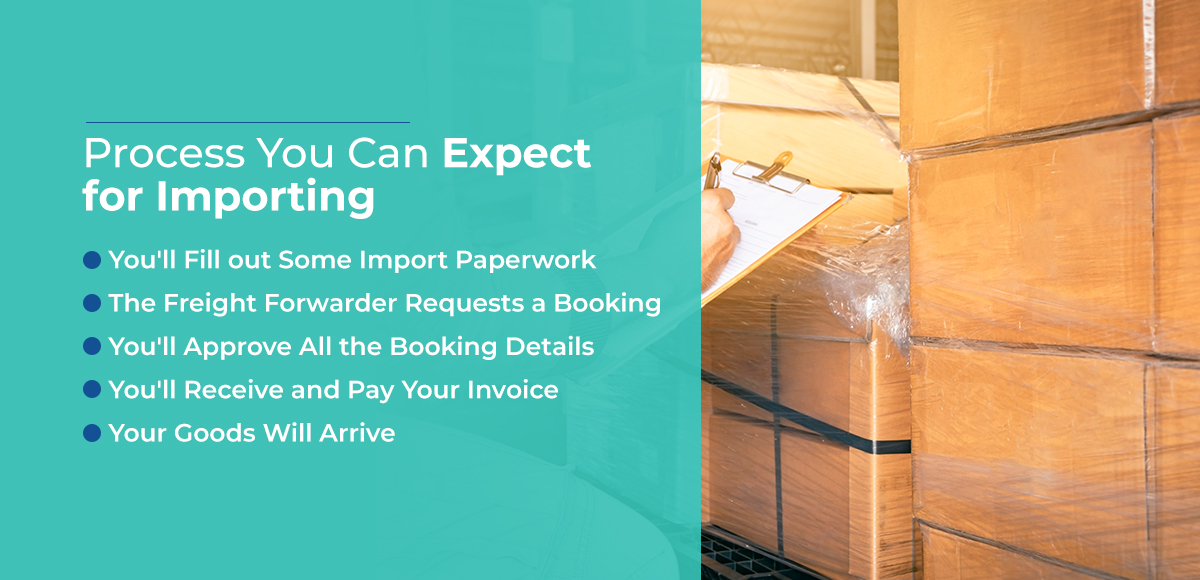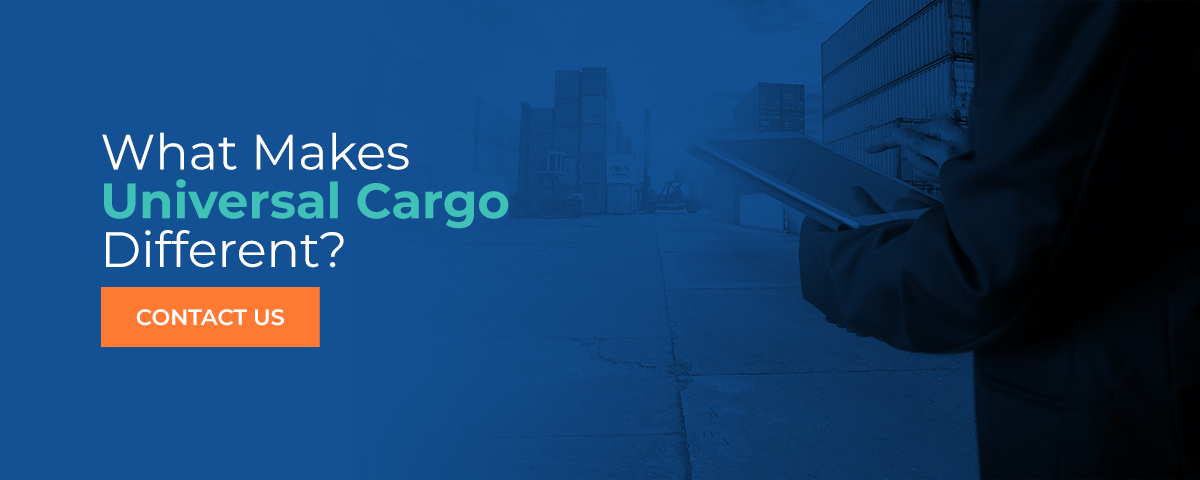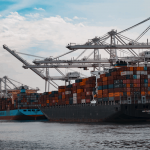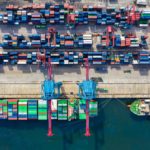Importing and Exporting Process When Working With a Freight Forwarder
After you give the freight forwarder your information on shipment specs and they return a quote, where does it go from there? Well, once you have a quote, the power is in your hands. You decide whether to agree to the arrangements. But you might be concerned about what the process looks like after you accept the quote. You’ll want to know what happens next and especially what you’ll need to do before you decide to import or export with a freight forwarder.
Learn what to expect with a freight agent or when working with a freight forwarder like Universal Cargo.

Process You Can Expect for Importing
Importing goods to the United States is a complicated process because of all the rules and regulations involved in U.S. customs. Working with a freight forwarder makes the importing process much smoother, as they’ll handle all the details so your items arrive safely in the U.S. After you accept your freight forwarder’s quote, the process of importing from China or another country to the U.S. follows five steps.
1. You’ll Fill out Some Import Paperwork
When importing goods, you’ll need a power of attorney (POA) agreement. Your POA is a legal document that allows your freight forwarder to handle the customs clearance process on your behalf. You’ll need to provide:
- An IRS, importer ID number or a social security card and driver’s license
- A “doing business as” (DBA) certificate if doing business under a trade name other than your official legal business name
- Your full name and the official legal name your business is registered as
- The jurisdiction where your company operates
- An authorized signature from an officer at your company
Your freight forwarder will also request additional information to create a Standard Operating Procedure (SOP) for your shipment. The SOP is a document that lays out the details and expectations for the shipping process. The details could involve a delivery schedule, the procedure for approving changes, the descriptions of the products you’re shipping, the contact information for shipping alerts and other information.
Your freight forwarder cannot proceed without the POA or the SOP, so it’s essential to pass this paperwork along quickly.
2. The Freight Forwarder Requests a Booking
With all the information and legal authority needed to handle your import, your freight forwarder can reach out to a customs broker to request a booking. They’ll coordinate the air or ocean carrier to get the goods to customs and ensure an agent handles the customs clearance process at the port.
3. You’ll Approve All the Booking Details
Once the booking is coordinated, your freight forwarder will pass along all the details for you to sign off on. You should receive:
- Your information as the shipper and co-signee
- Details about your goods, including the commodity descriptions and volumes
- Estimated time of departure (ETD), or the date when your carrier will depart with your goods
- Estimated time of arrival (ETA), or the date when your goods will arrive at their final destination
- The cutoff date, or the last day that the goods may arrive at the port to make the trucker’s estimated time of departure
- The cargo ready date, or the day your goods will be ready for pickup at their starting port
- Cost of the shipment.
Once you approve of all these details, your freight forwarder will confirm your booking. The import process will commence according to the details you’ve discussed.
4. You’ll Receive and Pay Your Invoice
Typically, your payment will be due before your goods have been delivered at their final destination and after they’ve been submitted for customs clearance. At that point, you’ll receive an invoice and all the payment details from your freight forwarder. In most cases, this invoice will include all charges.
5. Your Goods Will Arrive
Once the goods have cleared customs, they’ll be ready for pickup at the shipping port or airport. Typically, you’ll have worked with your freight forwarder to discuss trucking transportation to your facility from the port. A week after the carrier’s ETD, a few more documents will come through — a worksheet (WS) and debit note (DN) — which your freight forwarder can handle.
Process You Can Expect for Exporting
The exporting process for shipping from the U.S. to another country is a little different. Luckily, a freight forwarder can handle all the details for you so your items arrive at your customer or international location safely and quickly. Once you accept a quote from your freight forwarder, the process looks like this:
1. You’ll Fill out Some Export Paperwork
The export paperwork differs from the import paperwork. The main thing you need here is a shipper’s letter of instruction (SLI). Your freight forwarder should send you an SLI to fill out and return and request a commercial invoice and packing list (CIPL) to confirm what you’re exporting for the customs declaration.
The SLI conveys your export’s important details, such as where it is going and how to ship it. This document grants the freight forwarder permission to handle customs on the export side. Next, your CIPL will be used in customs to determine the value and quantity of the exported items. The commercial invoice should include:
- Country of origin
- Supplier or manufacturer information
- The full name and business address of the customer buying the shipped goods and a note on whether it’s a different entity than the importer
- The full name and address of the recipient of the freight
- Quantity of the units for each product, plus the unit value and an accurate product description
The packing list should include the weight, dimensions, quantity and carton count of the products. The PL should match the CI.
Once you have provided these documents, your freight forwarder can prepare all official export documentation for you.
2. You’ll Receive and Pay Your Invoice
Once you’ve confirmed all the details with your freight forwarder, they’ll draw up an invoice for all the shipping and exporting fees based on the volume and weight of your shipment.
3. Your Freight Forwarder Will Request a Booking
Once you pay your invoice, your freight forwarder will request the booking with a shipping carrier. The air or ocean carrier will take your goods to the destination shipping port or airport, where they will go through customs clearance and then on to their final destination.
Does This Include Trucking?
In most cases, no. The process we’ve outlined thus far is for air and ocean importing and exporting. It’s a smart idea to coordinate trucking alongside this process. Experienced freight forwarders like Universal Cargo offer trucking freight transport services in addition to air and ocean freight, allowing you to take advantage of intermodal shipping.
We recommend coordinating trucking during the export or import process before requesting a booking with a carrier. This measure ensures a truck will be ready to pick up your freight at the shipping port or airport in your good’s destination country and take them to their final destination. It’s important to talk to your freight forwarder about trucking needs. They can recommend carriers and coordinate the shipping process from the starting point to the end destination so the entire shipping process goes smoothly and efficiently.
What Makes Universal Cargo Different?
Universal Cargo is an experienced, full-service freight forwarder that can get your goods imported or exported via ocean freight or shipped via air freight to or from the U.S. Our services include door-to-door shipping, where we’ll also coordinate trucking on the import or export side of the shipment, customs clearance and more. We’ve built our business on strong industry relationships, which means we can find reliable partners for your unique shipments and the best rates possible.
We’ve been importing and exporting to and from the U.S. for more than 30 years, and we work hard to deliver the best customer experience. When you work with us, you’ll have a dedicated salesperson to guide you through the process and ensure your goods get to where you need them to go. To coordinate a shipment, contact us and request a rate today.




